A few days ago, Caroline (@caro-art) and I took a trip to Burgundy (France), mainly with the idea to visit the Guédelon castle construction site. Yes, they're building a full-fledged castle in the forest of the Puisaye, using only medieval techniques and tools! It's an experiment, and tourists are invited on the construction site to watch them do it. I had last been to Guédelon in 2016, and I'm happy to report that a lot of progress has been made in the last six years!
Naturally, this short trip was also a perfect opportunity to get a bit of camping in, and to get our new 5-months-old Maltese puppy used to the idea of traveling. It goes without saying, that we don't just went straight there, but sampled all manner of roadside attractions on the way. Watch the video, and read the photo story below for all the details.
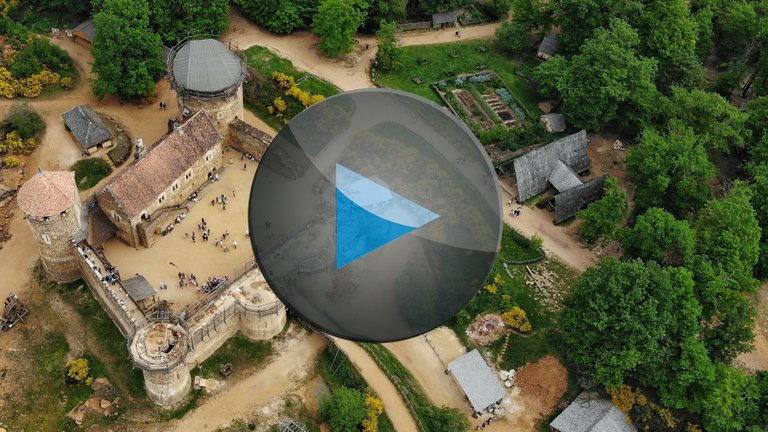
[ watch this video on folkerwulff.com ]
Vor ein paar Tagen sind Caroline (@caro-art) und ich nach Burgund (Frankreich) gefahren, hauptsächlich mit der Idee, die Baustelle der Burg Guédelon zu besuchen. Ja, im Wald der Puisaye wird eine vollwertige Burg gebaut, und zwar nur mit mittelalterlichen Techniken und Werkzeugen! Es ist ein Experiment, und Touristen sind eingeladen, auf der Baustelle zuzuschauen. Das letzte Mal war ich 2016 in Guédelon, und ich freue mich, dass in den letzten sechs Jahren viele Fortschritte gemacht worden sind!
Natürlich war dieser Kurztrip auch die perfekte Gelegenheit, um ein wenig zu campen und unseren neuen 5 Monate alten Malteserwelpen ans Reisen zu gewöhnen. Es versteht sich von selbst, dass wir nicht einfach nur dorthin gefahren sind, sondern auf dem Weg dorthin diverse Attraktionen am Straßenrand gesehen haben. Seht euch das Video an, und lest die Fotostory unten, um alle Einzelheiten zu erfahren.
Fosse Dionne
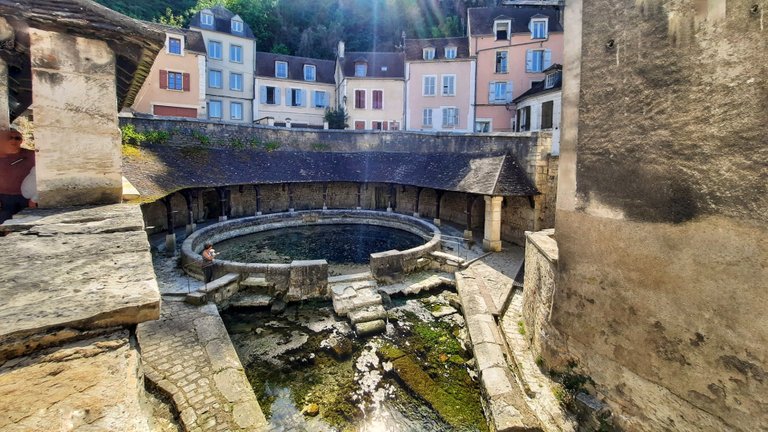
In Tonnerre (Département Yonne) there is a curious kind of karst spring called the Fosse Dionne. Curious because in the 18th century, they captured the spring in a lavoir (washhouse) which, of course, led to the downstream pollution of the crystal-clear spring water with all manner of soap and dirt!
The deep spring ("fosse" = "pit") is fed by the rainwater on the surrounding hills as well by at least one subterranean river. The exact extend of the underlying cave system is unexplored to this day as diving is extremely dangerous. The Fosse Dionne is remarkable because of its average daily outflow of 311 liters per second. However, during heavy rains and floods this can increase to 6,000 liters per second!
In Tonnerre (Département Yonne / Frankreich) gibt es eine kuriose Karstquelle namens Fosse Dionne. Kurios deshalb, weil man im 18. Jahrhundert die Quelle in einem Lavoir (Waschhaus) gefasst hat, was natürlich dazu führte, dass das kristallklare Quellwasser im Unterlauf mit allerlei Seife und Dreck verschmutzt wurde!
Die tiefe Quelle ("fosse" = "Grube") wird durch das Regenwasser der umliegenden Hügel sowie durch mindestens einen unterirdischen Fluss gespeist. Die genaue Ausdehnung des darunter liegenden Höhlensystems ist bis heute unerforscht, da das Tauchen extrem gefährlich ist. Die Fosse Dionne ist bemerkenswert wegen ihres durchschnittlichen täglichen Abflusses von 311 Litern pro Sekunde. Bei starken Regenfällen und Überschwemmungen kann dieser Wert jedoch auf 6.000 Liter pro Sekunde ansteigen!
Moulin Dautin
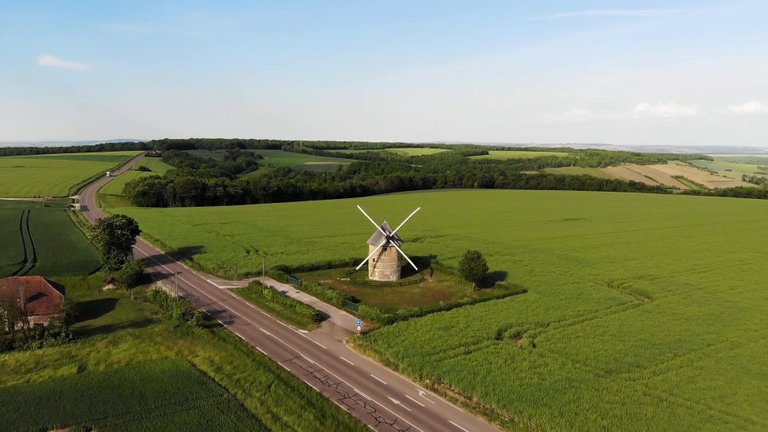
Right alongside the Route nationale 151 near Migé (Département Yonne) there stands Sieur Dautin's historic windmill. The mill has been restored to its former functionality in 1994 and I understand it can be visited. Unfortunately, the place was closed when we got there, and nobody was home for inquiries in the farmhouse accross the way. The Moulin Dautin is the only historic mill able to grind wheat in all of Burgundy.
Direkt an der Route nationale 151 bei Migé (Département Yonne) steht die historische Windmühle des Sieur Dautin. Die Mühle wurde 1994 restauriert und kann, soweit ich weiß, besichtigt werden. Leider war sie geschlossen, als wir dort ankamen, und im gegenüberliegenden Bauernhaus war niemand zu Hause, um nachzufragen. Die Moulin Dautin ist die einzige historische Mühle in ganz Burgund, die Weizen mahlen kann.
Lac du Bourdon - An EPIC Camp Spot!
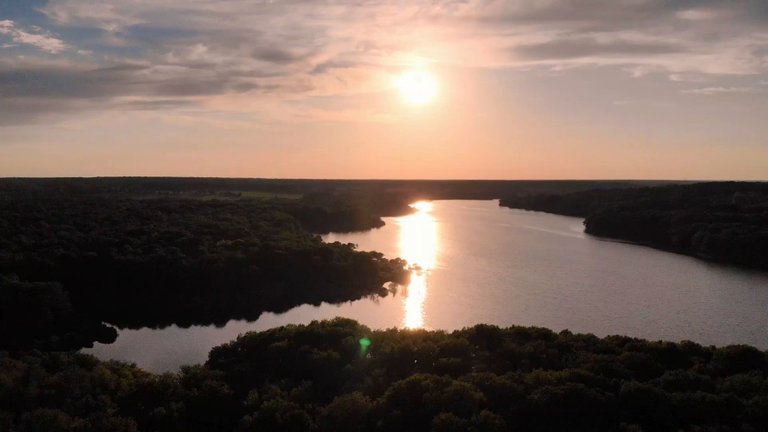
In the Puisaye, between St. Fargeau and Moutiers-en-Puisaye (Département Yonne) lies the Lac du Bourdon. In 1901 this lake was artificially created to supply the Canal de Briare with water. However, nature has long since regained the upper hand, so that the lake is practically indistinguishable from a natural one.
The lake is surrounded by dense deciduous forests, it's huge, and it's gorgeous! There are campgrounds and day-use parking lots at the lake, but now in the off-season everything is still closed. This opens the door to wild camping. Although officialy prohibited, the French are incredibly tolerant with campers if one doesn't overdo it. Know how, know where, and thread lightly...
Thanks to Google Earth it's easy to figure out where you could get from the road to the lake shore with a van. For those of you who would also like to camp there I recommend my campsite at coordinates 47°36'06.8"N 3°07'12.7"E trusting that you will leave the site as clean as you found it. At these coordinates, the D485 road passes so close to the lake that you can easily finesse a camper van (not a mobile home!) between the trees to the beach.
CAVEAT for campers: As you can see in the video, I took the liberty of building a small campfire because the vegetation is currently in full sap. In summer, when the forest is dry, I would not recommend this to anyone and in France this is also punishable by heavy fines!
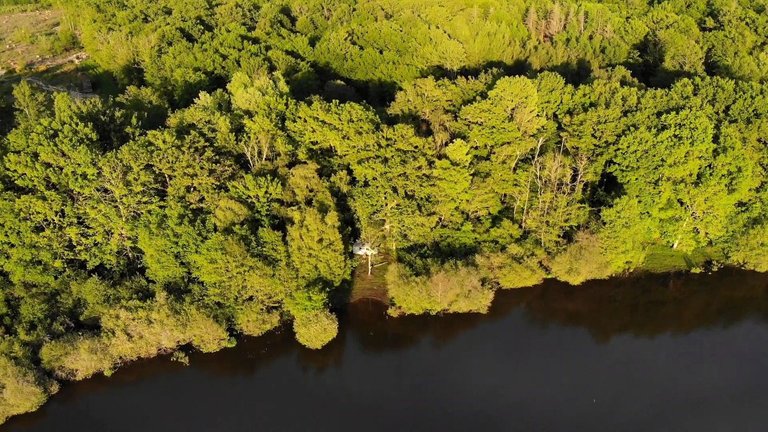
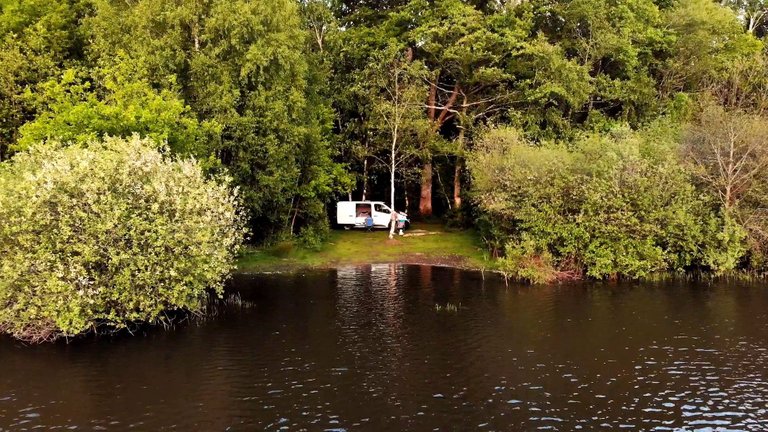
Im Puisaye, zwischen St. Fargeau und Moutiers-en-Puisaye (Département Yonne) liegt der Lac du Bourdon. Dieser See wurde 1901 künstlich aufgestaut, um den Canal de Briare mit Wassser zu versorgen. Die Natur hat inzwischen allerdings längst wieder die Oberhand gewonnen, so dass der See sich praktisch nicht mehr von einem natürlichen unterscheidet.
Der See ist von dichten Laubwäldern umgeben, riesengroß und wunderschön. Es gibt Campingplätze und Tagesparkplätze am See, aber jetzt in der Nebensaison ist alles noch geschlossen. Das erlaubt es, Wildcamping zu veranstalten, weil die Franzosen trotz offiziellen Verbots da unheimlich tolerant sind. Gewusst wie, gewusst wo...
Dank Google Earth ist es leicht, herauszufinden, wo man mit einem Van von der Strasse ans Seeufer gelangen könnte. Wer von euch auch gerne mal dort campen würde, dem empfehle ich meinen Stellplatz an den Koordinaten 47°36'06.8"N 3°07'12.7"E im Vertrauen darauf, dass ihr den Platz so sauber verlasst, wie ihr ihn vorfindet. An dieser Stelle geht die Strasse D485 so dicht am See vorbei, dass man problemlos mit einem Van (allerdings keinem Wohnmobil!) zwischen den Bäumen zum Wasser fahren kann.
CAVEAT für Camper: Wie man im Video sieht, habe ich mir erlaubt, ein kleines Lagerfeuer zu machen, weil die Vegetation derzeit noch voll im Saft steht. Im Sommer, wenn der Wald trocken ist, würde ich das niemandem empfehlen und es wird in Frankreich auch mit empfindlichen Geldbußen bestraft!
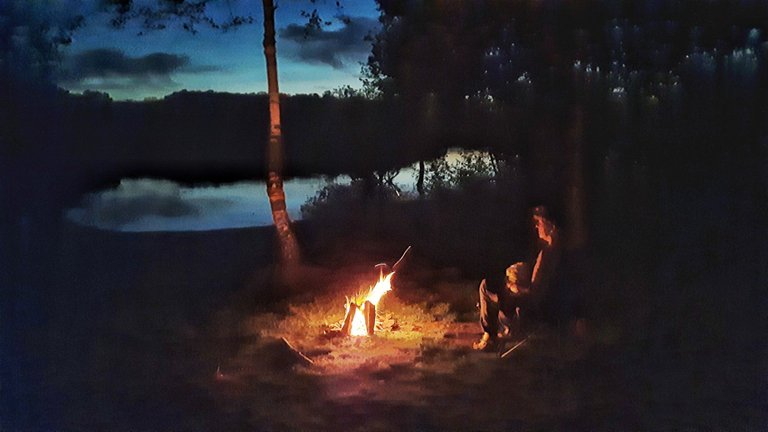
Guédelon: They're Building a CASTLE!
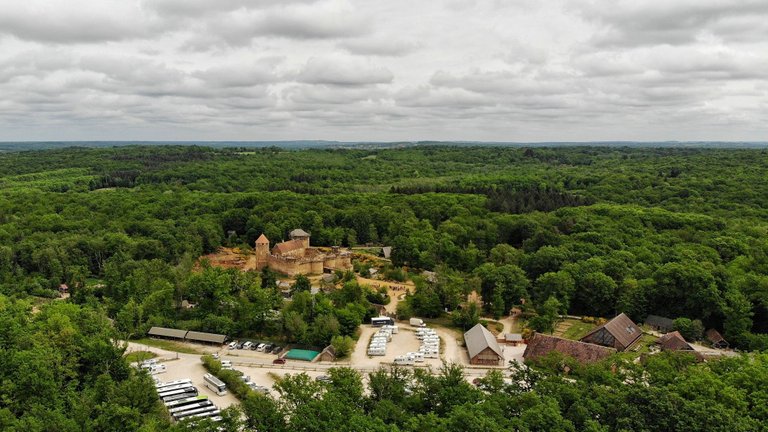
Since 1997, they're building a full-fledged castle in the dense forest of the Puisaye, using only medieval techniques and tools! It's an archeological experiment, and about 300,000 tourists annually are flocking to the construction site to watch them do it. The castle is projected to be finished next year, and by the looks of it, that seems realistic. Guédelon can be visited March through November.
Seit 1997 wird im dichten Wald der Puisaye eine vollwertige Burg gebaut, und zwar ausschließlich mit mittelalterlichen Techniken und Werkzeugen! Es handelt sich um ein archäologisches Experiment, zu dem jährlich etwa 300.000 Touristen auf die Baustelle pilgern, um dabei zuzusehen. Die Burg soll im nächsten Jahr fertiggestellt werden, und so wie es aussieht, scheint das auch realistisch zu sein. Guédelon kann von März bis November besucht werden.



The chosen site is ideal for this, as all required construction materials are readily available in the surroundings: stone from an abandoned quarry, timber from the large forest, water from a nearby pond, limestone, clay... From the middle ages to today: transport is cumbersome and expensive, so selecting a building site wisely can pay off in a big way.
Der gewählte Standort ist dafür ideal, denn alle benötigten Baumaterialien sind in der Umgebung reichlich vorhanden: Stein aus einem stillgelegten Steinbruch, Holz aus dem großen Wald, Wasser aus einem nahe gelegenen Teich, Kalkstein, Lehm... Vom Mittelalter bis heute: Transport ist anstrengend und teuer; eine geschickte Wahl des Baugründstücks kann sich richtig auszahlen.
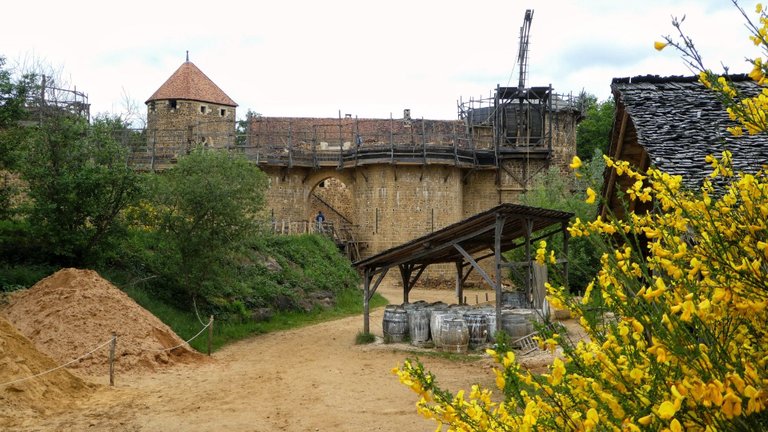
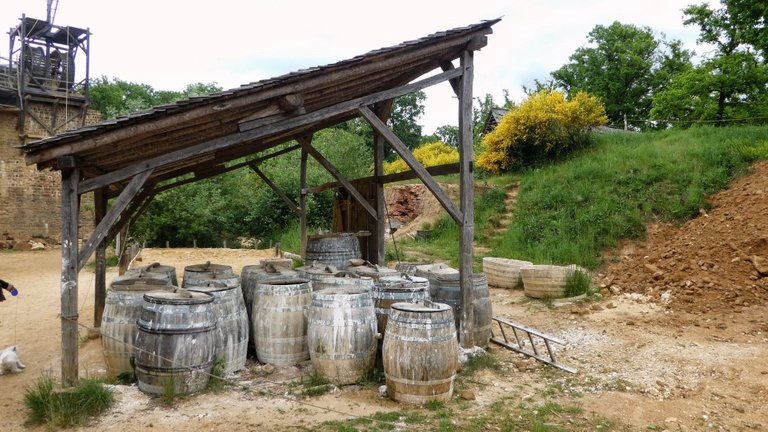
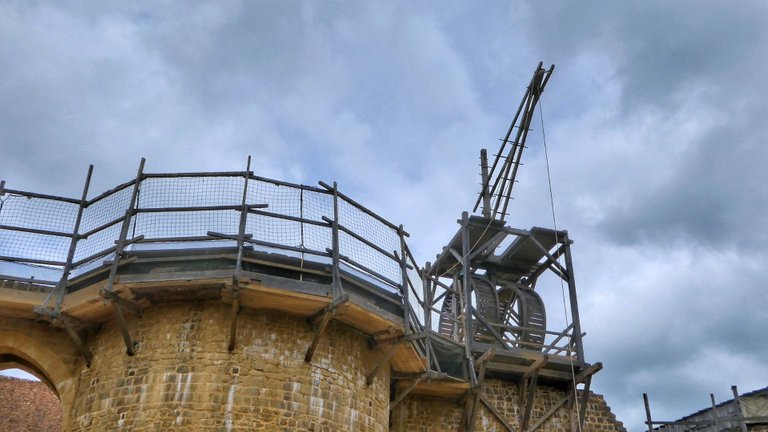
Michel Guyot, owner of the nearby castle of Saint-Fargeau, had the original idea for Guédelon, following the success of the historical festival of Saint-Fargeau that he organized to finance the restoration of his castle. So he set up a scientific committee and a builders' association to support the project, raising more than four million francs thanks to the support of the European Union, the Burgundy region, and other contributors. Subsequently, a public company was created to replace the association, a for-profit company that does not receive subsidies.
Michel Guyot, Eigentümer des nahe gelegenen Schlosses von Saint-Fargeau, hatte die ursprüngliche Idee für Guédelon nach dem Erfolg des historischen Festivals von Saint-Fargeau, das er zur Finanzierung der Restaurierung seines Schlosses organisiert hatte. Er gründete ein wissenschaftliches Komitee und einen Bauherrenverein, um das Projekt zu fördern, und konnte dank der Unterstützung der Europäischen Union, der Region Burgund und anderer Geldgeber mehr als vier Millionen Francs aufbringen. Später wurde anstelle des Vereins ein öffentliches Unternehmen gegründet, das keine Subventionen erhält und gewinnorientiert arbeitet.

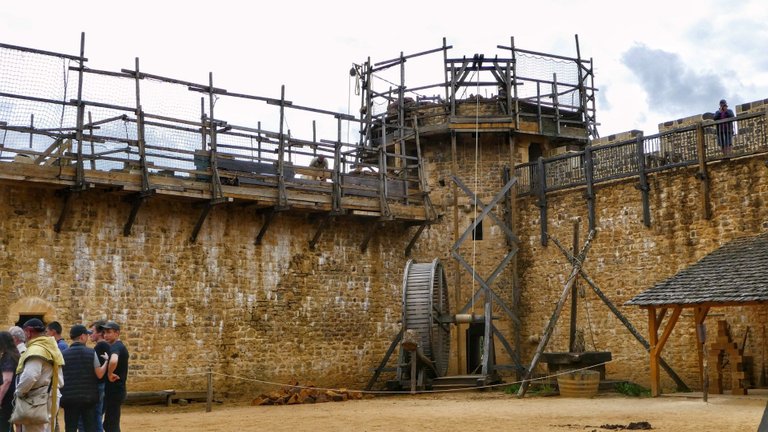
Thirty-five people were hired, including masons, professional carpenters and unskilled workers, in addition to a hundred or so occasional volunteers. At the outset, most of the difficulties were addressed only as they arose. The initial concept did neither include proper plans with exact quantities for construction materials, nor was the chronology of the work clear.
The first thing to be done was to deal with the immediate: the manufacture of mortar, the cutting and supply of stone. Thirty thousand tons of sandstone were needed for the construction of the castle, the woods needed clearing, and the construction site had to be flattened...
Fünfunddreißig Personen wurden eingestellt, darunter Maurer, professionelle Zimmerleute und ungelernte Arbeiter, sowie etwa hundert gelegentliche Freiwillige. Zu Beginn wurden die meisten Schwierigkeiten angegangen, wie sie auftraten. Das ursprüngliche Konzept enthielt weder richtige Pläne mit genauen Mengenangaben für die Baumaterialien, noch war die zeitliche Abfolge der Arbeiten klar.
Als erstes musste das Unmittelbare in Angriff genommen werden: die Herstellung von Mörtel, das Schneiden von und die Versorgung mit Steinen. Dreißigtausend Tonnen Sandstein wurden für den Bau des Schlosses benötigt, Wald musste gerodet und das Baugelände eingeebnet werden...
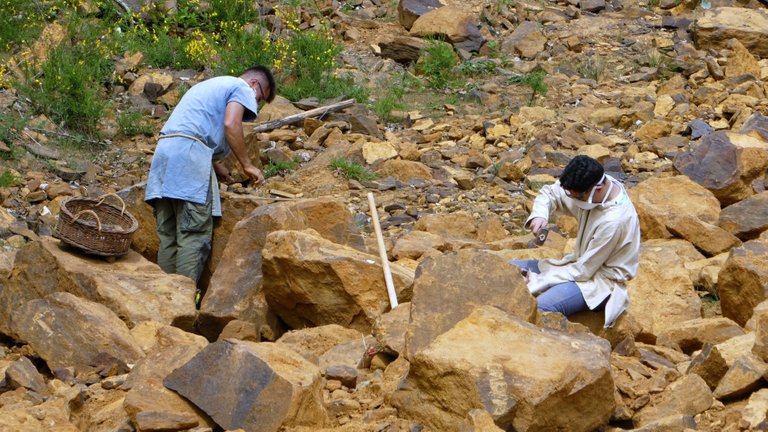
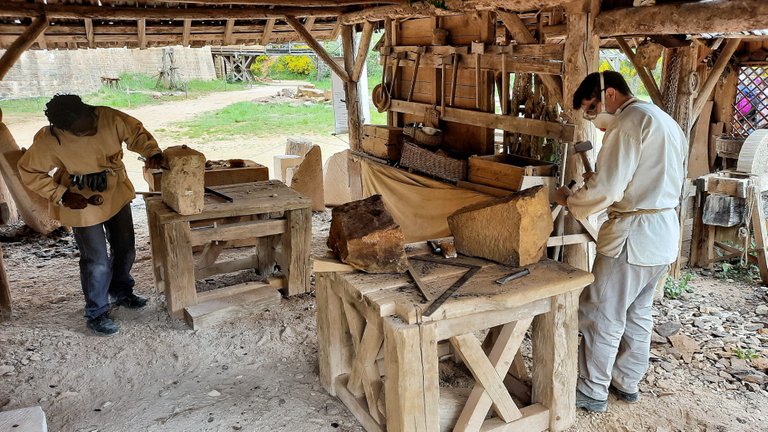
As this wasn't our first visit to the castle construction site, we didn't visit all the trades and shops present at Guédelon. Although it is very interesting to watch these people at their medieval toils, it's less so on the second go-around. But I can assure you, they're all there: stone miners, stonemasons, limeburners, blacksmiths, carpenters, wagoners, basket weavers, ropemakers, brickmakers, potters... The list goes on and on!
Da dies nicht unser erster Besuch auf der Baustelle der Burg war, haben wir nicht alle Handwerksbetriebe und Werkstätten in Guédelon besucht. Es ist zwar sehr interessant, diese Menschen bei ihrer mittelalterlichen Schufterei zu beobachten, aber beim zweiten Mal nicht mehr ganz so sehr. Aber ich kann euch versichern, dass sie alle da sind: Steinbrecher, Steinmetze, Kalkbrenner, Schmiede, Zimmerleute, Fuhrleute, Korbflechter, Seiler, Ziegelbrenner, Töpfer... Eine richtig lange Liste!
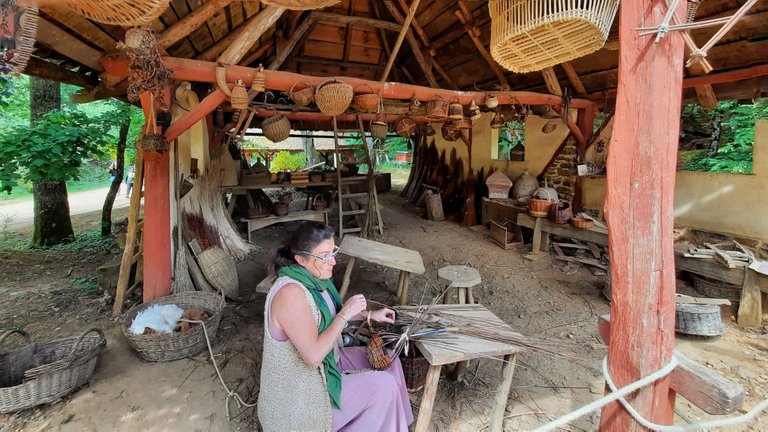
There is even some animal husbandry happening, which makes me suspect the next stage of the project is a full-fleged medieval village around the finished castle. It would make sense, and at 15.00 EUR a pop times 300k visitors each year Guédelon has turned into the proverbial goose that lays golden eggs, in an area that has virtually no jobs and no infrastructure to brag about. I know we'll be coming back for more...
Es wird sogar etwas Viehzucht betrieben, was mich vermuten lässt, dass die nächste Stufe des Projekts ein vollwertiges mittelalterliches Dorf rund um die fertige Burg ist. Das erscheint logisch, und bei 15,00 EUR pro Person und 300.000 Besuchern im Jahr ist Guédelon zur sprichwörtlichen Gans, die goldene Eier legt, geworden - in einer Gegend, in der es praktisch keine Arbeitsplätze und keine Infrastruktur gibt, mit der man angeben könnte. Ich weiß, dass wir wiederkommen werden...
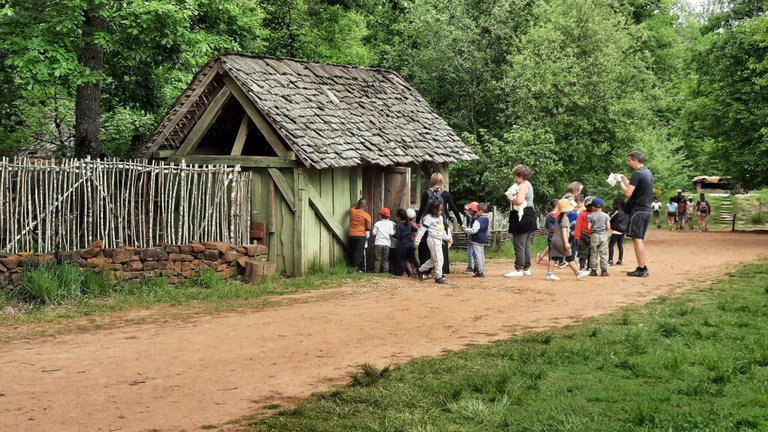
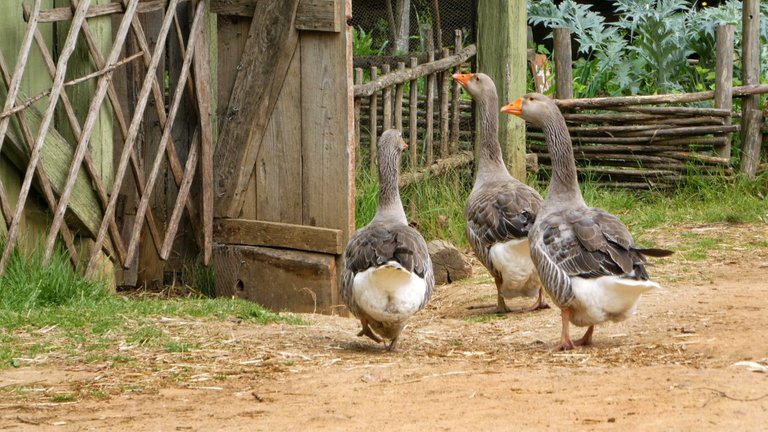
CAVEAT for drone pilots: AirMap shows the area around Guédelon as "green" and wide open, subject only to the standard French and European regulations, e.g. license and insurance. However, the Guédelon site is private property and drone flying is prohibited by the owner. Since Guédelon objects only to overflights and not filming as such, I obtained the drone footage in my video by flying close to the property line and filming in 4K with heavy zoom and additional cropping-in in post to 1080p to create the illusion of closeness.
CAVEAT für Drohnenpiloten: AirMap zeigt das Gebiet um Guédelon als "grün" und offen an, das nur den üblichen französischen und europäischen Vorschriften unterliegt, u.a. Flugschein und Versicherung. Das Gelände von Guédelon ist jedoch Privatbesitz, und der Eigentümer verbietet das Fliegen von Drohnen. Weil Guédelon nur die Überflüge und nicht das Filmen an sich vermeiden will, habe ich die Drohnenaufnahmen in meinem Video gemacht, indem ich an die Grundstücksgrenze herangeflogen bin und in 4K mit viel Zoom gefilmt habe. In Post habe ich die Clips dann nochmal auf 1080p beschnitten um die Illusion von Nähe zu erzeugen.
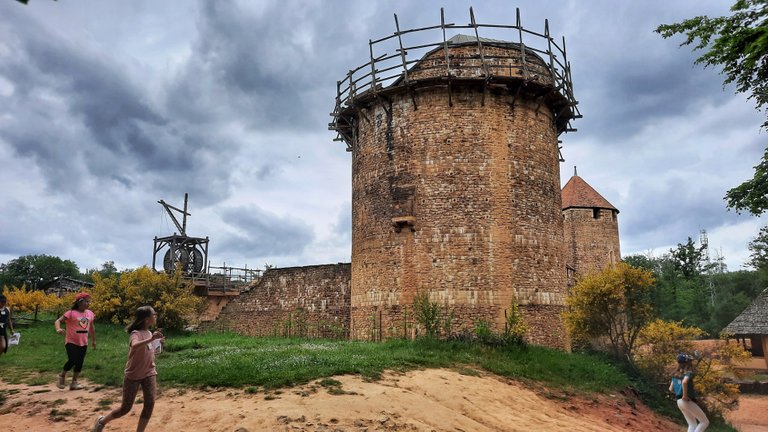
Les Sept Écluses
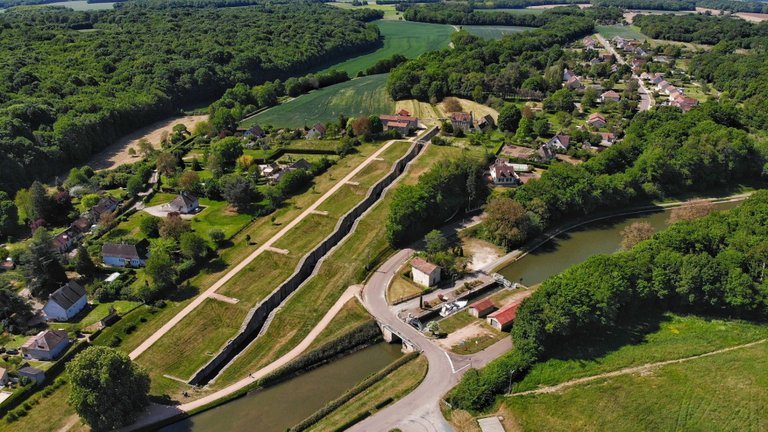
I have mentioned the Canal de Briare in passing, writing about the Lac du Bourdon above. In Rogny-les-Sept-Écluses (Département Yonne) we now encounter the main work of this canal, a lock staircase of seven locks dating from 1642. These locks were originally built to join the Loire to the Seine, as part of the ambitiuous Plan of Henri IV to join the Mediterranean Sea to the English Channel.
As we can see from the air, the locks are empty and have long been replaced by a newer system, in 1887 to be precise. Still, each lock is 27 m long, for an impressive total of 238 m. The lock staircase of Rogny was designated a national historical monument in 1983.
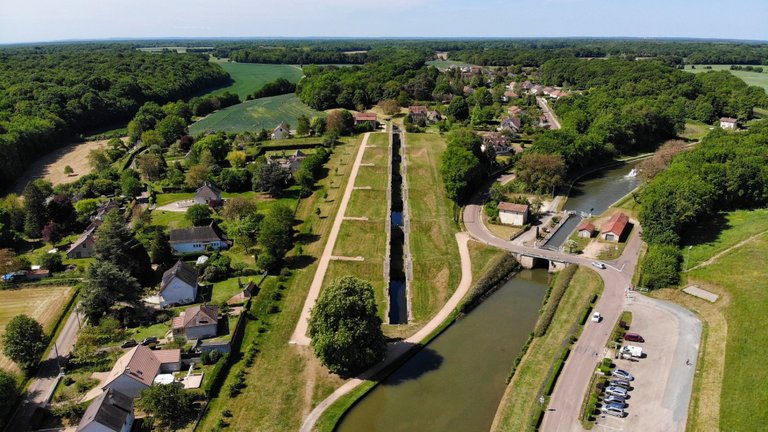
Ich habe den Canal de Briare nur am Rande erwähnt, als ich oben über den Lac du Bourdon sprach. In Rogny-les-Sept-Écluses (Département Yonne) treffen wir nun auf das Hauptwerk dieses Kanals, eine Schleusentreppe mit sieben Schleusen aus dem Jahr 1642. Diese Schleusen wurden ursprünglich gebaut, um die Loire mit der Seine zu verbinden, als Teil des ehrgeizigen Plans von Henri IV, das Mittelmeer mit dem Ärmelkanal zu verbinden.
Wie man aus der Luft sehen kann, sind die Schleusen leer und wurden längst durch ein neueres System ersetzt, genauer gesagt im Jahr 1887. Dennoch ist jede Schleuse 27 m lang, was eine beeindruckende Gesamtlänge von 238 m ergibt. Die Schleusentreppe von Rogny wurde 1983 zum nationalen historischen Denkmal erklärt.
Moving On to the Loire
 The Loire near Sait-Benoît-sur-Loire • Die Loire bei Sait-Benoît-sur-Loire
The Loire near Sait-Benoît-sur-Loire • Die Loire bei Sait-Benoît-sur-Loire
Near Rogny-les-Sept-Écluses we cross over from Yonne into the département Loiret and the region Val de Loire, to reach one of the most beautiful rivers of the World: the Loire is still mostly free-flowing; no dams or locks influence its natural course. Due to the large amount of bedload it transports, it constantly changes appearance; sandbanks and river islands are constantly built up and shifted again, to provide ideal living conditions for flora and fauna.
Because of the beauty of the valley, the French nobility preferred to settle here from the beginning of the Renaissance in the 16th century and built magnificent castles on the Loire. In 2000, the Loire Valley between the towns of Sully-sur-Loire and Chalonnes-sur-Loire was declared a UNESCO World Heritage Site. We'll have a quick look a Sully in a bit, but for now, let's explore a lesser-known gem of the Loire valley:
Nahe Rogny-les-Sept-Écluses wechseln wir von Yonne ins Département Loiret und die Region Val de Loire, um einen der schönsten Flüsse der Welt zu erreichen: Die Loire ist noch weitgehend frei fließend; keine Dämme oder Schleusen beeinflussen ihren natürlichen Lauf. Durch die große Menge an Geschiebe, die sie transportiert, verändert sie ständig ihr Aussehen; Sandbänke und Flussinseln werden immer wieder aufgeschüttet und verlagert, um ideale Lebensbedingungen für Flora und Fauna zu schaffen.
Wegen der Schönheit des Tals siedelte sich der französische Adel seit Beginn der Renaissance im 16. Jahrhundert bevorzugt hier an und baute an der Loire prächtige Schlösser. Im Jahr 2000 wurde das Loiretal zwischen den Städten Sully-sur-Loire und Chalonnes-sur-Loire von der UNESCO zum Weltkulturerbe erklärt. Gleich werden wir uns Sully ganz kurz ansehen, aber jetzt wollen wir erst einmal ein weniger bekanntes Kleinod des Loire-Tals erkunden:
The Oratory of Theodulf: Carolingian Church from 806 A.D.
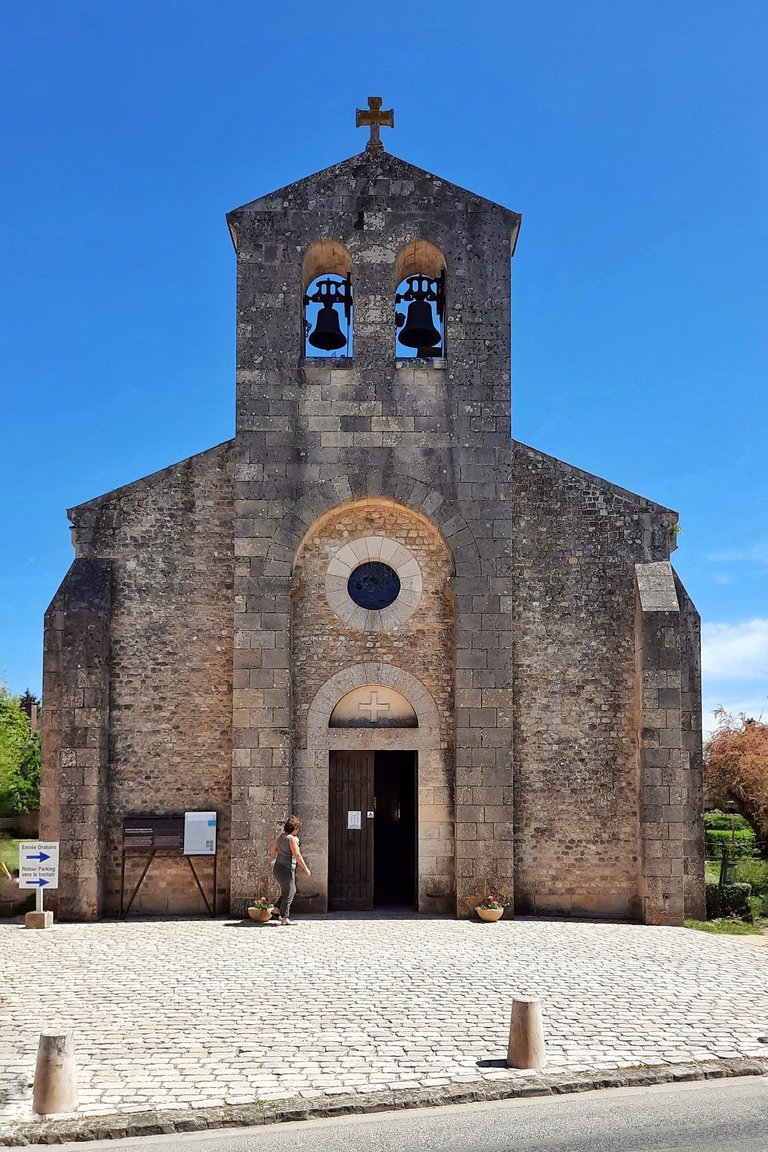
In Germigny-des-Prés (Département Loiret) we visit the Oratory of Bishop Theodulf of Orléans, one of the most celebrated men of letters in the Carolingian Empire court of Charlemagne. In 806 A.D., Theodulf established his palace complex in Germigny-des-Prés, modelled on Charlemagne's Palace of Aachen (Germany). Alas, the Vikings ransacked and leveled the place, leaving only the oratory which serves as a humble parish church today.
In Germigny-des-Prés (Département Loiret) besichtigen wir das Oratorium des Bischofs Theodulf von Orléans, eines der berühmtesten Literaten am Hof des Karolingerreiches unter Karl dem Großen. Im Jahr 806 n. Chr. errichtete Theodulf seinen Palastkomplex in Germigny-des-Prés nach dem Vorbild des Aachener Palastes von Karl dem Großen. Leider plünderten und zerstörten die Wikinger die Anlage und hinterließen nur das Oratorium, das heute als bescheidene Pfarrkirche dient.
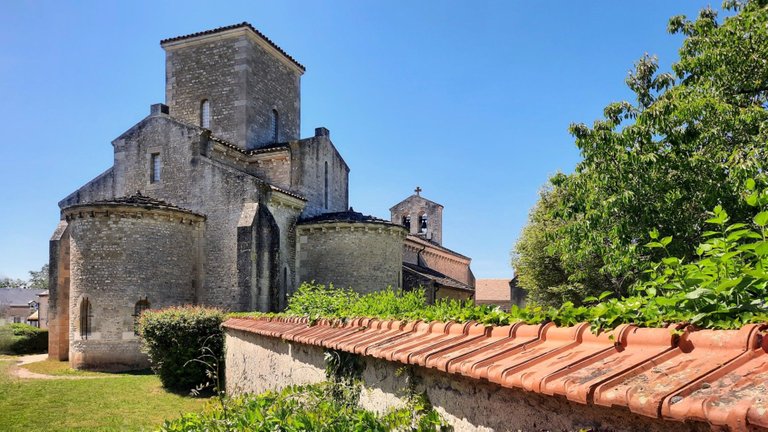
Wikipedia informs us, that the oratory took the form of a rough square with single apses in the middle of the north, south, and west sides, and three apses on the east side. Internally, the space took the form of a Greek cross: a high central tower filled the central bay, barrel vaults extended off in the north, south, east, and west bays, while in the corner bays there were low domes carried on squinches. This plan type was later to become standard in Byzantine architecture.
Wikipedia informiert uns, dass das Oratorium die Form eines groben Quadrats mit einzelnen Apsiden in der Mitte der Nord-, Süd- und Westseite und drei Apsiden auf der Ostseite hatte. Im Innern hatte der Raum die Form eines griechischen Kreuzes: Ein hoher Mittelturm füllte das zentrale Joch, Tonnengewölbe erstreckten sich in den Nord-, Süd-, Ost- und Westjochen, während sich in den Eckjochen niedrige Kuppeln befanden, die auf Kniestücken ruhten. Dieser Grundrisstyp sollte später in der byzantinischen Architektur zum Standard werden.
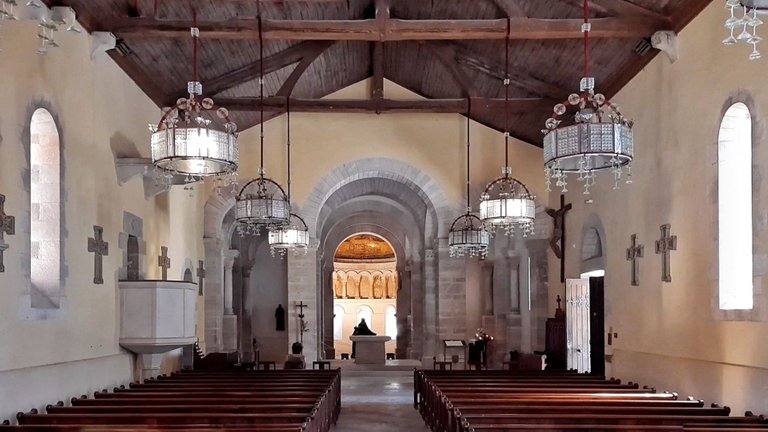
The great treasure of the church is the mosaic of the Ark of the Covenant, on the ceiling of the apse. This mosaic is the only surviving Byzantine mosaic in France, although traces of mosaics elsewhere on the roof indicate that it was part of a wider decorative scheme. The mosaic owes its preservation to being plastered over at the time of the French Revolution; it was rediscovered in the middle of the 19th century. Below his mosaic, Theodulf placed an inscription that occupies two lines:
As you gaze upon the holy propitiatorium and the Cherubim, beholder,
And see the shimmering of the Ark of God's covenant,
Perceiving these things, and prepared to beseech the Thunderer with prayers,
Add, I beg you, Theodulf's name to your invocations.
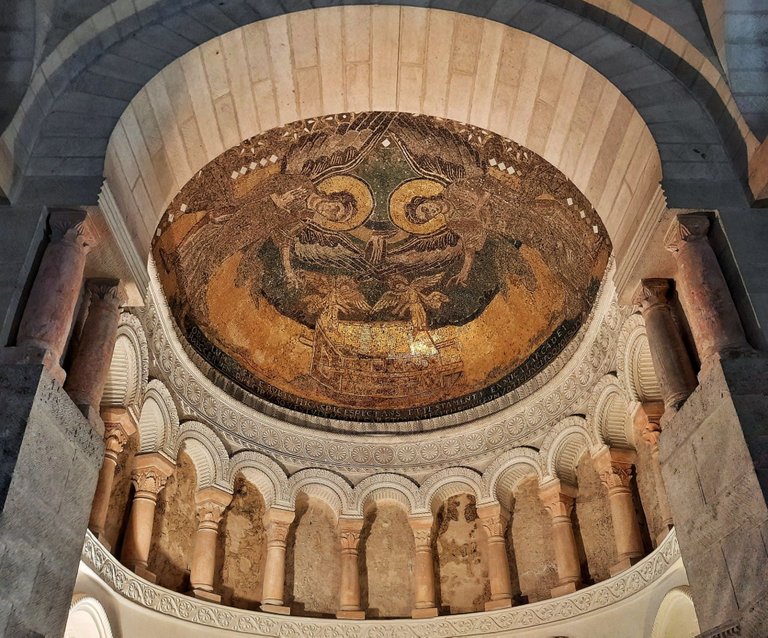
Der größte Schatz der Kirche ist das Mosaik der Bundeslade, das sich an der Decke der Apsis befindet. Dieses Mosaik ist das einzige erhaltene byzantinische Mosaik in Frankreich, obwohl Spuren von Mosaiken an anderen Stellen der Decke darauf hindeuten, dass es Teil eines größeren Dekorationsplans war. Die Erhaltung des Mosaiks ist darauf zurückzuführen, dass es zur Zeit der Französischen Revolution zugegipst wurde; es wurde Mitte des 19. Jahrhunderts wiederentdeckt. Unter seinem Mosaik hat Theodulf eine zweizeilige Inschrift angebracht:
Wenn du auf das heilige Propitiatorium und die Cherubim blickst, Betrachter,
Und siehst das Schimmern von Gottes Bundeslade,
Dies erkennend, und bereit, den Donnerer mit Gebeten anzuflehen,
Füge, ich bitte dich, Theodulfs Namen zu deinen Bitten hinzu.
Château de Sully-sur-Loire
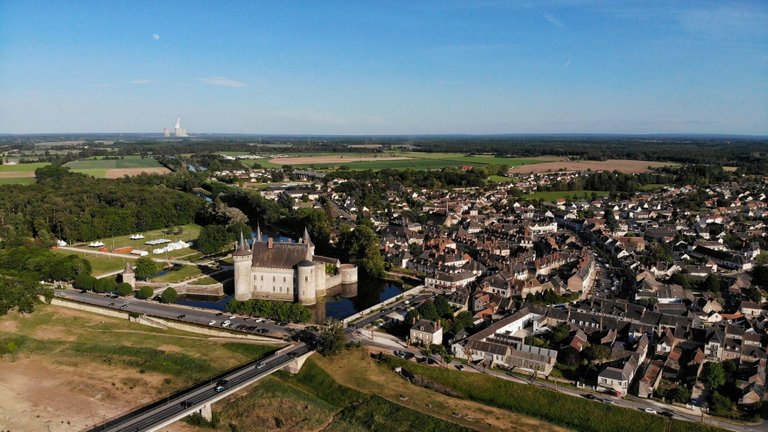
Just a few miles upstream from Germigny-des-Prés, Sully-sur-Loire (Département Loiret) is located on the left bank of the Loire. The river is particularly wide and shallow here, which is why there was a ford here as early as the Middle Ages. Sully, or better, the Château de Sully, is the starting point for many Loire chateau tours.
The Château de Sully is located directly on the left bank of the Loire and was originally intended as a castle for military control of the ford. It used to be located almost in the middle of the river, which is why the castle moat is particularly wide. The complex was built and converted into the stately home of the Duke of Sully between the 14th and 17th centuries. The oldest part of the complex is the high donjon facing the Loire, enclosed by fat round towers at the corners.
Nur ein paar Kilometer flussaufwärts von Germigny liegt Sully-sur-Loire (Département Loiret) am linken Ufer der Loire. Der Fluss ist hier besonders breit und flach, weswegen es hier schon im Mittelalter eine Furt gab. Sully, oder besser, das Château de Sully, ist der Ausgangspunkt für viele Loire-Schlösserreisen.
Das Schloss von Sully liegt direkt am linken Ufer der Loire und war ursprünglich als Burg zur militärischen Kontrolle der Furt gedacht. Früher lag es fast mitten im Fluss, weshalb der Schlossgraben auch besonders breit ist. Die Anlage wurde zwischen dem 14. und 17. Jahrhundert errichtet bzw. zum herrschaftlichen Schloss des Herzogs von Sully umgebaut. Der älteste Teil der Anlage ist der zur Loire hin gelegene hohe Donjon, der von dicken Rundtürmen an den Ecken eingefasst wird.
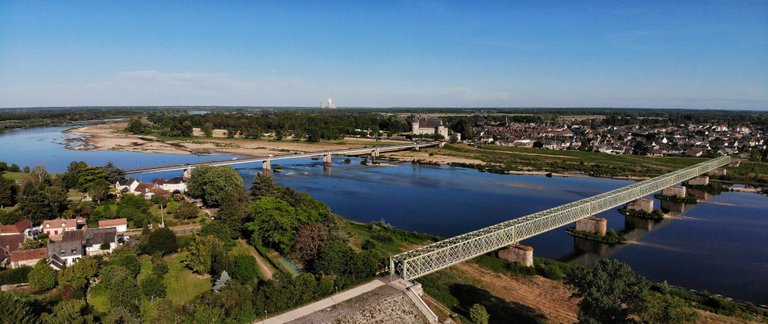
Caroline and I have visited the château several times before, so I'll leave it at an approach flight with the drone this time around. Nevertheless, the Château de Sully is really worth seeing, especially the roof trusses of the donjon, which is considered some of the most beautifully crafted and preserved roof timbering from the Middle Ages. So please, do as I say and not as I do, and be sure to look at the inside of the château as well!
Caroline und ich waren schon früher mehrfach zur Besichtigung im Schloss, weshalb ich es dieses Mal bei einem Anflug mit der Drohne belasse. Das Château de Sully ist dennoch wirklich sehenswert, besonders der Dachstuhl des Donjons, der als einer der handwerklich kunstvollsten und schönsten, die aus dem Mittelalter erhalten sind, gilt. Also bitte, schaut euch das Schloss unbedingt auch von innen an!
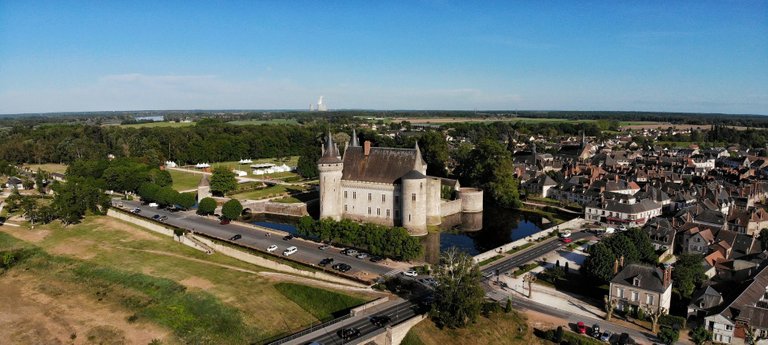
As you are reading this, I ask you to keep in mind that we were on the road for some relaxing camping and "puppy training", and not for cultural edification by means of forced sightseeing marches. In terms of camping Sully has something to offer as well: A nice aire, i.e. a free camp site, is located within walking distance directly behind the castle on the riverbank, and the center of this cute little town is also within easy walking distance from there. This campground is also suitable for large motorhomes.
Those who like their camping a bit quiter can stay overnight in the shady parking lot of the picnic area near the steel grid pedestrian bridge (see pictures) on the right bank, which is what we did. However, this place is restricted to 2.20 m vehicle height by a barrier and thus not accessible for all vans. There is a ban on motorhomes and caravans there, but as the locals assured me, small campers are tolerated for up to 48 hours. My "stealth camper" is a Renault, which passes for a delivery van anywhere, so I don't worry about this stuff.
Ich bitte beim Lesen zu bedenken, das wir zum entspanenden Camping und "Welpentraining" unterwegs waren und nicht zur kulturellen Erbauung mittels Besichtigungs-Gewaltmärschen. Auch in Punkto Camping hat Sully was zu bieten: Eine schöne Aire, also ein Gratis-Campingplatz, liegt fußläufig direkt hinter dem Schloß am Flußufer und auch das Zentrum des schnuckeligen Städtchens ist von dort leicht zu Fuß zu erreichen. Dieser Platz ist auch für große Wohnmobile nutzbar.
Wer es ruhiger mag, kann wie wir auf dem schattigen Parkplatz des Picknick-Geländes bei der Stahlgitter-Fußgängerbrücke (siehe Bilder) am rechten Ufer übernachten. Dieser Platz ist aber mit einer Schranke auf 2,20 m Fahrzeughöhe begrenzt und damit nicht für alle Vans zugänglich. Es gibt dort ein Verbot für WoMos und Caravans, aber wie mir die Einheimischen versicherten, werden kleine Camper bis zu 48 Stunden lang geduldet. Mein "Stealth-Camper" ist ein Renault, der überall als schnöder Lieferwagen durchgeht, so dass ich mir um den Kram keine Gedanken mache.
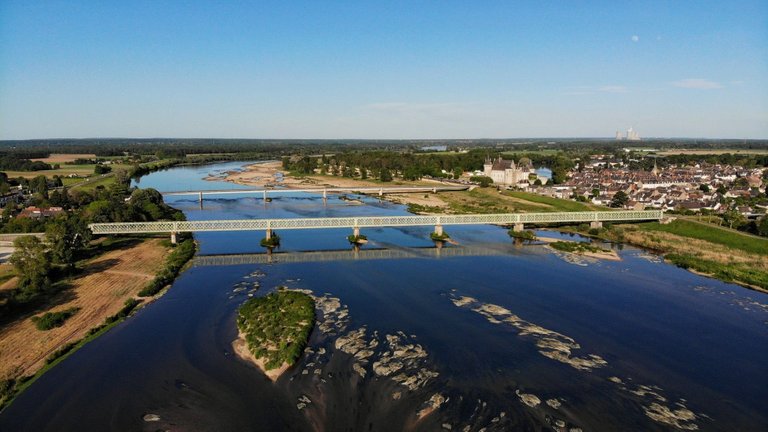
Château de La Motte-Tilly
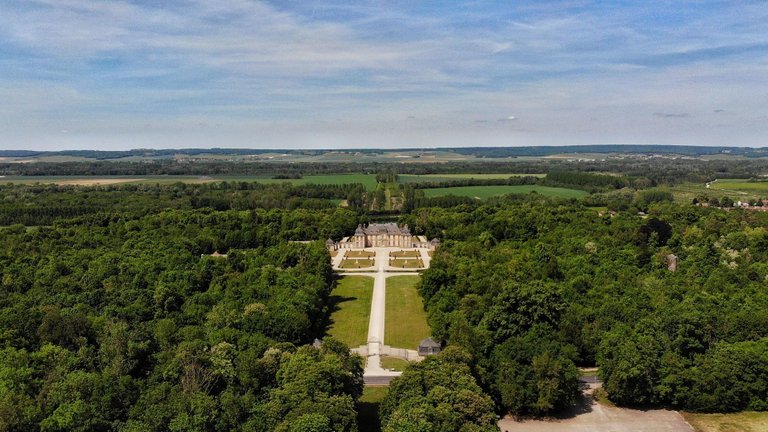
As always, we used only byways on our way home to Germany, and near the small town of La Motte-Tilly (Département Aube near Nogent-sur-Seine) we got a payoff once again by happening on this beautiful manor house. Unfortunately, it was closed to the public that day (off season) but thanks to the drone, we got a look at the grounds at least.
Notwithstanding that La Motte-Tilly is still described as a "château", the current building is in fact a house in the French baroque style, and is not fortified. In this it is similar to many other French country houses, where the nomenclature has expanded beyond the strictly accurate. The château is managed by the Centre des monuments nationaux and can be visited, so I put it on "the list" for a later time.
Wie immer haben wir auf dem Heimweg nach Deutschland nur Nebenstraßen benutzt, und in der Nähe der kleinen Stadt La Motte-Tilly (Département Aube bei Nogent-sur-Seine) wurden wir wieder einmal fündig, als wir auf dieses schöne Herrenhaus stießen. Leider war es an diesem Tag für die Öffentlichkeit geschlossen (Nebensaison), aber dank der Drohne konnten wir zumindest einen Blick auf das Gelände werfen.
Ungeachtet der Tatsache, dass La Motte-Tilly immer noch als "Schloss" bezeichnet wird, handelt es sich bei dem heutigen Gebäude tatsächlich um ein Haus im französischen Barockstil, das nicht befestigt ist. In dieser Hinsicht ähnelt es vielen anderen französischen Landhäusern, bei denen die Nomenklatur über die Genauigkeit weit hinausgeht. Das Schloss wird vom Centre des monuments nationaux verwaltet und kann besichtigt werden, so dass ich es für einen späteren Zeitpunkt auf "die Liste" gesetzt habe.
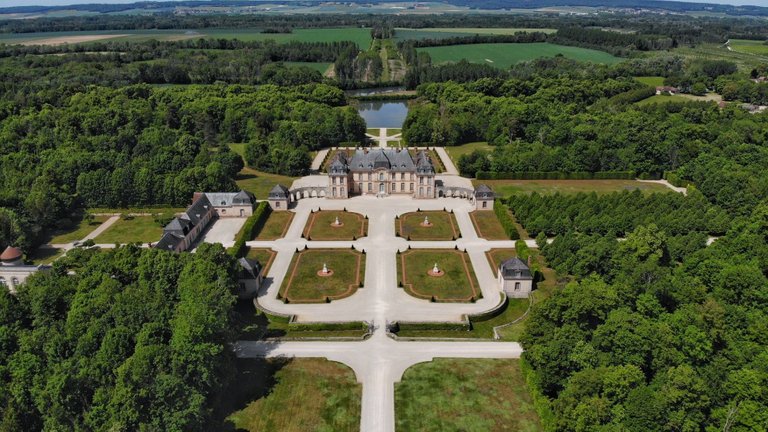
Finally, I'd like to ask you a favor: Although this was only a trip of a few days, I brought home over 500 media files that needed to be sifted through, sorted, and edited. In addition to this detailed blog post, I spent quite a few hours to produce what I'd like to think of as an entertaining little movie. So please watch it!
That said, thanks for watching, thanks for reading, and please don't forget to upvote and reblog if you liked my post. Until next time!
Zum Schluß möchte ich euch um einen Gefallen bitten: Obwohl dies nur ein Trip von ein paar Tagen war, habe ich doch über 500 Mediendateien nach Hause gebracht, die gesichtet, sortiert und aufbereitet werden wollten. Ich habe zusätzlich zu diesem ausführlichen Blogpost etliche Stunden in die Produktion eines - wie ich meine - unterhaltsamen kleinen Films gesteckt. Bitte schaut ihn euch auch an!
Und damit danke fürs Anschauen, danke fürs Lesen, und vergesst bitte nicht das Upvoten und Rebloggen, wenn euch mein Beitrag gefallen hat. Bis zum nächsten Mal!

[ watch this video on folkerwulff.com ]
Tolle Aufnahmen und Supervideo.
Danke!
!LUV
!BEER
!invest_vote
Reblog
Dankeschön, und Danke fürs Anschauen :-)
Ich habe zu danken - sehr schöne Impressionen. Vermutlich sind die Restriktionen für Drohnen in Frankreich genauso übel wie in Deutschland.
Das beste ist, vor 2 Wochen war ich in Krefeld an der Burg Linn, deren Geschichte sogar bis ins tiefste Mittelalter zurückreicht.
Beste Grüße
!LUV
Die Drohnenregeln in Frankreich sind einigermaßen okay. Weniger Stückwerk als bei uns, würde ich sagen, man weiß also, woran man ist.
Schade, dass innerhalb geschlossener Ortschaften das Fliegen fast überall verboten ist. Gut jedoch, dass es fast immer einen Park o.ä. als Ausnahme gibt, sodass man wenigstens ein paar Aufnahmen in der Stadt bekommt.
Bei uns ist das größte Handicap das Überflugverbot von Bundesstraßen, Wasserstraßen, Eisenbahnen und Stromtrassen mit 100m Abstand. Da bleibt fast nix mehr übrig, wenn man sich daran hält. Gut: Aufstieg über Privatgelände ist meistens möglich, auch innerstädtisch. Halt kurz um Erlaubnis bitten und gut ist.
Die europäischen Regeln sind insgesamt fair und sinnvoll. Man hat aber versäumt, die nationalen Regeln auszuhebeln, was zur Abwechslung mal vernünftig gewesen wäre. Naja...
Airmap für Burg Linn: Da kannste die Drohne höchstens am Besenstiel in die Luft halten. Besonders die Nationalparkregelung ist völliger Schwachsinn. Einzig die Warnung für den Flughafen kann man gelten lassen.
Airmap für Guédelon: Die halbe Puisaye ist grün und frei zu fliegen. Das Flugverbot über der Burg kommt nur vom Besitzer, dessen Hausrecht natürlich trotzdem zu respektieren ist. Es ist auch vernünftig mit sovielen Kindern, die da rumlaufen.
!BEER
!invest_ vote
!LUV
!PIZZA
!wine
@janasilver denkt du hast ein Vote durch @investinthefutur verdient!@janasilver thinks you have earned a vote of @investinthefutur !
!PIZZA für die Hilfe der Burg das macht hungrig😎
Dankeschön :-)
Congratulations, your post has been added to Pinmapple! 🎉🥳🍍
Did you know you have your own profile map?
And every post has their own map too!
Want to have your post on the map too?
I've heard of that castle but have never been myself. I think that it's a really cool concept. It's neat that you can see how they build and craft the different elements there as well.
Great drone footage. Your wife playing with the puppy at the camping site is a cute scene.
You should really go before the season is on. Careful, hotels are somewhat hard to come by around St. Fargeau, so you might have to stay in Auxerre (which is pretty nice in its own right).
I cut all the personal scenes out, me as a lumberjack and such. The puppy is a lot of fun and really a good travel companion. A people pleaser. He was a hit with all the kids in Guédelon 🤣
It seems like we pass by that area quite a bit on our way to other places, but we rarely stop. I recall seeing signs for Auxerre many times. I'll have to try and get there at some point.
Yeah puppies sare usually a pretty big hit with kids. You probably heard a lot of "Petit chien, petit chien" being said around you lol
Please do, it's nice and thinly settled, so not too many crowds. Yeah, the most common word we heard was "bébé!", ear-piercingly so, that it got on our nerves at times :-) The little one is really so friendly and outgoing, he loves people. Only other animals make him growl and bark like a big one. (In the video, barking at the horse going by.) I guess he'll be protective, too.
Sounds like a good combination of traits in a dog :)
That's really quite something to build a castle like in the old days. When did the project first start? Was it when you first visited in 2016 or even before that?
The project started in 1997, but there wasn't that much to see, really, at the time. That and other factoids are in my text :-)
Daily Travel Digest #1564.
Become part of our travel community:
- Join our Discord
- Learn more about our travel application
Hiya, @LivingUKTaiwan here, just swinging by to let you know that this post made it into our Top 3 in Your post has been manually curated by the @pinmapple team. If you like what we're doing, please drop by to check out all the rest of today's great posts and consider supporting other authors like yourself and us so we can keep the project going!Thank you kindly :-)
Wow such beautiful places and the pictures are great capture. It seems like lot of fun and relaxing time with the traveling. Hope to visit such wonderful places one day. Thank you for sharing with us @wuff-media.
Thank you. Yes, it was fun and relaxing, and that's the idea in my old age :-) By all means, travel as much as you can. Spending money on experiences is more valuable than accumulating things.
Komplett verpennt!
Kennd schlimma sinn. Fleeh in de Unnerbux zum Beispill. :-)
Dann iss awwer Jääps un Trallala aaangesaat! Leck misch ... alään de Gedange macht misch worres.
Nidd so schlimm wie Sackradde, aber schlimmer wie gekrault :-)
The castle looks like one of these which could easily appear in series like Game of Thrones or The Hobbit, lol. Nice one!
And I absolutely love love the drone shots! They give such a different perspective over everything. Great job!
Thank you Gabriela. Yes, the castle looks absolutely authentic. I've seen enough "real" castles and I see no difference. Only the huge breach in the wall appears to be a concession to modern safety standards as rescue vehicles would never make it under the portcullis. That, too, is something I noticed only after seeing their progress ("Why is there still a hole in the wall?") and seeing it from above.
Excellent shots and post! Would love to have you come join our new Drone community!
Looking forward to seeing more. https://ecency.com/created/hive-186141
Thank you. Yes, I subscribed to your community. Looks like fun :-)